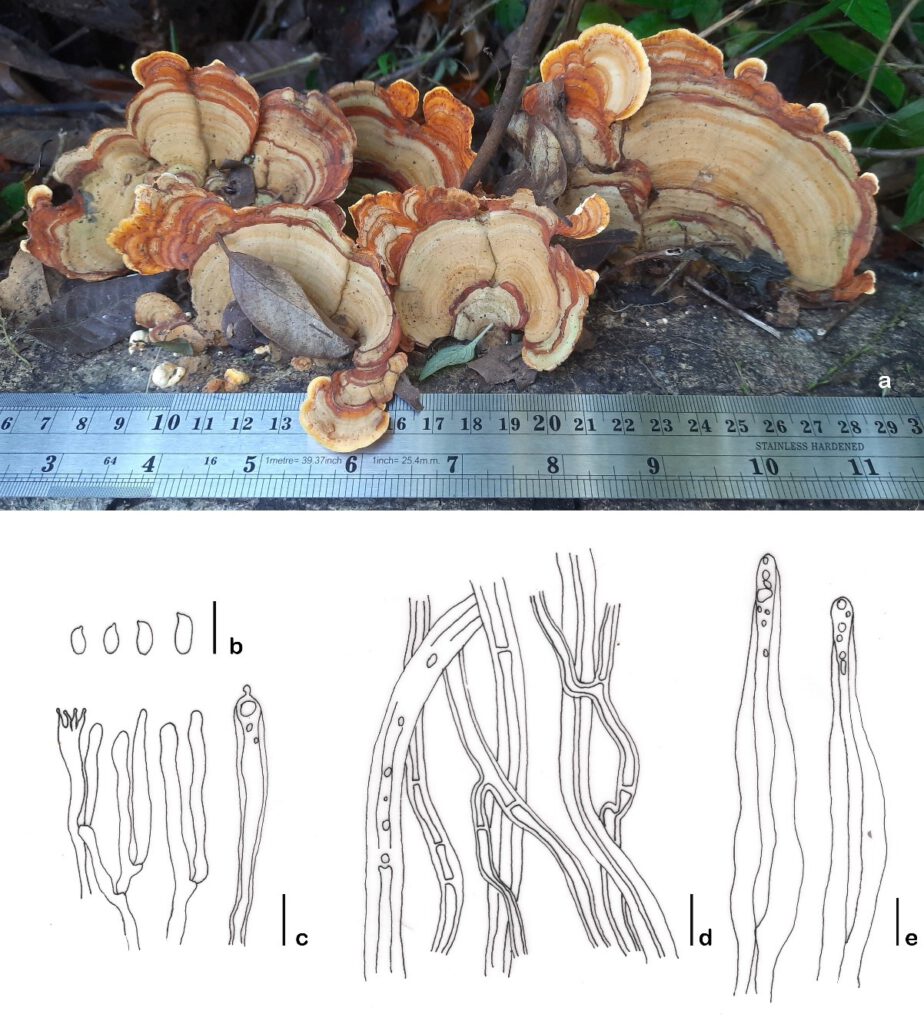Fungalpedia – Note 135 Stereum
Stereum Hill ex Pers.
Citation if using this entry: Bera et al. (in prep) Basidiomycota. Mycosphere.
Index Fungorum, Facesoffungi, MycoBank, GenBank, Fig. 1
Basidiomycota, Agaricomycetes, Russulales, Stereaceae
The name “Stereum” was first used in a generic sense by John Hill in 1751 (Chamuris 1988). From 1955 to 1968, emphasizing the micro-morphological characters, Stereum was defined in a more restricted manner to only the closely related taxa of the type species, S. hirsutum (Willd.) Pers. (Boidin 1958, Pouzar 1959, Parmasto 1968, Chamuris 1988, Eicker & Louw 1998). The generic characteristic features that delimited the genus are the stipitate to effuso-reflexed, or dirnidiate or resupinate habit, presence of encrusted cystidia (gloeocystidia or sulfocystidia), and clamp connections in both basidia and hyphae (Eicker & Louw 1998). Thus, after narrowing the concept of Stereum, the genus represented a homogenous, natural, monophyletic group (Chamuris 1988).
Currently, classified under the order Russulales (based on molecular data and certain microscopical characters), Stereum is characterized by its annual or perennial, papery, tough basidiomata (Eicker & Louw 1998, Ţura et al. 2008). The pileus cover is trichodermoid, transitions into a crust resembling that of a fomitoid (Ţura et al. 2008). The evenly and variably coloured hymenium sometimes turns into reddish or yellowish orange on bruising (Ţura et al. 2008). Transverse sections of the context often show dark reddish deposits between the core and tomentum (Ţura et al. 2008). The presence of weakly amyloid basidiospores and lactiferous hyphae confirms its systematic position in the Russuloid clade (Larsson & Larsson 2003, Larsson 2007, Ţura et al. 2008). The hyphal system can be monomitic or dimitic with thick-walled hyphae (Ţura et al. 2008). The compact nature of the hyphae makes Stereum basidiomata so tough (Ţura et al. 2008).
Stereum typically thrives in xerophilic environments, colonizing both fallen and upright branches, trunks, and stumps of deciduous and coniferous tree species. This white rot fungus has been reported globally both from coniferous forests of Europe and North America and arid zones of Asia, Africa, Australia, and the Middle East (Binyamini 1983, Breitenbach & Kränzlin 1986, Chamuris 1988, Ginns & Lefebvre 1993, Eicker & Louw 1998, Ţura et al. 2008).
The ecological significance of Stereum is its capacity to degrade wood and contribute to carbon cycling within arid forest ecosystems (Overholts 1939, Woon & Jung 1999). Another interesting fact about this genus is the presence of a wide array of secondary metabolites that are responsible for the antioxidant, cytotoxic, antibacterial, antifungal, antiviral, autophagy-inducing activities that make Stereum medicinally valuable as well (Çayan et al. 2019, Tian et al. 2020).
Type species: Stereum hirsutum (Willd.) Pers.
Figure 1. a. Stereum sp. (picture courtesy: Mr. Sabin Khyaju), b-e. Stereum hirsutum. a. Basidiomata. b. Basidiospores. c. Hymenial section showing hyphidia and basidia. d. Hyphae. e. Pseudocystidia. Scale bars: b-e = 10 μm. Drawn from Ţura et al. 2008.
References
Binyamini N 1983 – Lignicolous Aphyllophorales fungi from Israel IV (Corticiaceae II). Nova Hedwigia, 36(2–4), 291–308. https://pascal-francis.inist.fr/vibad/index.php?action=getRecordDetail&idt=9317367
Boidin J 1958 – Heterobasidiomycetes saprophytes et Homobasidiomycetes resupines V. Essai sur le genre Stereum Pers. Rev. Mycol., 23, 318–346. https://cir.nii.ac.jp/crid/1573105974743708416
Breitenbach J, Kränzlin F 1986 – Fungi of Switzerland, Vol. 2. Non gilled fungi-Heterobasidiomycetes, Aphyllophorales, Gasteromycetes. Verlag Mycologia, CH-6000 Lucerne 9, Switzerland, pp. 150. https://www.cabdirect.org/cabdirect/abstract/19861318678
Çayan F, Tel-Çayan G, Deveci E, Öztürk M, Duru ME 2019 – Chemical profile, in vitro enzyme inhibitory, and antioxidant properties of Stereum species (Agaricomycetes) from Turkey. International Journal of Medicinal Mushrooms, 21(11), 1075–1087. https://www.dl.begellhouse.com/journals/708ae68d64b17c52,25f9c61f6dbb0698,6ed54cfd4a51b041.html
Chamuris GP 1988 – The non-stipitate stereoid fungi in the northeastern United States and adjacent Canada. Mycologia Memoir, 14, 7–244. https://pascal-francis.inist.fr/vibad/index.php?action=getRecordDetail&idt=7086621
Eicker A, Louw S 1998 – Stereum species (Stereaceae) of South Africa. South African journal of botany, 64(1), 30–37. https://www.sciencedirect.com/science/article/pii/S0254629915308243
Ginns J, Lefebvre MNL 1993 – Lignicolous corticioid fungi of North America. Systematics, distribution and ecology. Mycologia Memoirs, 19, 1–247. https://books.google.co.th/books/about/Lignicolous_Corticioid_Fungi_Basidiomyco.html?id=-oWpyybKb3QC&redir_esc=y
Larsson E, Larsson KH 2003 – Phylogenetic relationships of russuloid basidiomycetes with emphasis on aphyllophoralean taxa. Mycologia, 95(6), 1037–1065. https://www.tandfonline.com/doi/abs/10.1080/15572536.2004.11833020
Larsson KH 2007 – Re-thinking the classification of corticioid fungi. Mycological research, 111(9), 1040–1063. https://www.sciencedirect.com/science/article/abs/pii/S095375620700175X
Overholts LO 1939 – The genus Stereum in Pennsylvania. Bulletin of the Torrey Botanical Club, 515-537. https://www.jstor.org/stable/2480841
Parmasto E 1968 – Conspectus systematis corticiacearum. Inst. Zool. Bot., Acad. Sci. RPSS. pp 261. https://cir.nii.ac.jp/crid/1570009750004274176
Pouzar Z 1959 – New gerena of higher fungi III. Ceska Mycol, 13, 10–19. https://cir.nii.ac.jp/crid/1570009750004275840
Tian M, Zhao P, Li G, Zhang K 2020 – In depth natural product discovery from the basidiomycetes Stereum species. Microorganisms, 8(7), 1049. https://www.mdpi.com/2076-2607/8/7/1049
Ţura D, Zmitrovich IV, Wasser SP, Nevo E 2008 – The genus Stereum in Israel. Mycotaxon, 106, 109–126. https://www.researchgate.net/profile/Ivan-Zmitrovich/publication/270881442_The_genus_Stereum_in_Israel/links/54b697790cf2e68eb27ea354/The-genus-Stereum-in-Israel.pdf
Woon LY, Jung HS 1999 – Taxonomic study on Korean Stereum. Korean J. Mycol., 27(5), 343–353. https://www.dbpia.co.kr/Journal/articleDetail?nodeId=NODE09599386
Entry by
Ishika Bera, Center of Excellence in Fungal Research, Mae Fah Luang University, Chiang Rai 57100, Thailand
(Edited by Kevin D Hyde)
